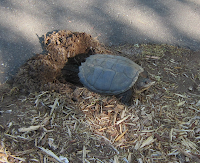By Naturalist, Licia Johnson
With the threat of White-nose Syndrome knocking at our door, the
latest discovery of the WNS fungus just detected at Maquoketa Caves State Park,
Iowa, just 30 miles from the SW corner
of Wisconsin, it is important now more than ever to get an understanding
of Wisconsin’s bat population.
 One way
citizens can become involved in this effort is to monitor our local bat
population with an acoustic monitoring detector.
One way
citizens can become involved in this effort is to monitor our local bat
population with an acoustic monitoring detector.
While we have trained over 60 volunteers in the past 3 years who
conduct these night-time surveys from May-September, I rarely get a chance to
take the equipment out myself to partake in this awesome experience. Well, this past Tuesday was my chance to get
out there. I met Discovery Center
member and trained bat surveyor, Ed Marshall, at his house on Squaw Lake in Lac
du Flambeau.
I arrived at 9pm (we have to start the surveys ½ hour after
sunset) to get all the equipment ready and to load up in the boat, and Ed was ready
to go - the sun setting and temperature at a comfortable 64
degrees. He had his electric Duffy boat,
aptly named the ‘Lac du Flambeau Queen,’ after its resemblance to a certain
famous 1951 action-adventure-romance flick, charging all day, so we would have
enough power to last throughout the survey.
We settled in, put all the equipment together, shoved off from the
dock….and the motor wouldn’t start.
Curious. I quickly reached out,
grabbed a half-submerged pipe to keep us from drifting too far out into the
lake. We docked the Duffy, and decided
to try out the Alumacraft fishing boat.
The motor started right up and we began our survey route along the edge
of Squaw Lake.
We had only about seven minutes of no bat activity before the
detector started going crazy. We could
see the bats flying over the surface of the lake-over 20 surrounded us at one
point. By looking at the sonogram that
showed on the equipment, I could tell they were little brown bats. This kind of activity continued for the next
hour and a half, I believe we also had big brown and hoary bats.
 As we conducted the survey, the temperatures began to drop. I believe that it got down into the upper
40’s, low 50’s towards the end. The
water temperature was over 71 degrees F.
This led to the occurrence of a steamy lake surface. As we glided over the lake, my hands were so
cold, but I could actually feel the warmth of the steam on my face as we cut
through it. It was such an amazing
feeling, and only could have been experienced while out surveying our nocturnal
flying mammals.
As we conducted the survey, the temperatures began to drop. I believe that it got down into the upper
40’s, low 50’s towards the end. The
water temperature was over 71 degrees F.
This led to the occurrence of a steamy lake surface. As we glided over the lake, my hands were so
cold, but I could actually feel the warmth of the steam on my face as we cut
through it. It was such an amazing
feeling, and only could have been experienced while out surveying our nocturnal
flying mammals.
The best part of doing these surveys is the results we
receive. After the survey is completed,
I download all the information stored in the detector on our route and all the
bats that we encountered. DNR folks in
Madison then analyze the data and send back a map of the route, along with the
location and species of all the bats we encountered during the survey.
We are anxiously awaiting our results and
will share them when we get them!








